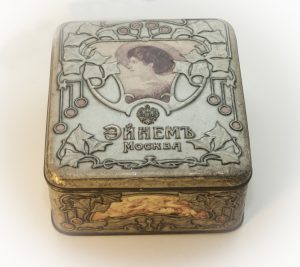Museum of Jelgava

Cookie box “EINEM”

Cepumu kārba EINEM, JVMM 33719
The first chocolate fabrics in Russian Empire started in the min 19th century by a french man Adolf Sioux and german Theodor Ferdinand von Einem. In 1851, Einem opened a small confectionery. Only four people worked there preparing chocolate candies.
With time the small confectionery grew into a factory by 1867, which produced chocolate candies, chocolate, marmalade, pastilles, marzipan, glazed fruits, cacao drinks, biscuits, etc. T. F. Einem was also a philanthropist. From every pound of cookies he sold, T. F. Einem gave five silver kopecks to charity – half of it went to charity establishment in Moscow, the other half to Moscow School for the German Poor and Orphans. After the death of T. F. Einem in 1876, the factory was taken over by his companion Julius Heiss, who kept the name “Einem”. In 1900, the Einem factory received Gran Prix in Exposition Universelle, and in 1913, the Einem factory received the title “Supplier of the Court of His Imperial Majesty”. It meant that the produce was of the highest quality and was appreciated in the Russian Empire. The Einem products were well known in Riga as well because there was a factory branch.
The product package was well-thought – the chocolate package’s interior was decorated with velvet, silk, and leather. It was designed by multiple artists. That was not all. In every package, there was a hidden surprise, such as notes for a melody composed by Karl Feldman. The Einem factory was the first that hid surprises in the packages for products for children similar to Kinder Surprise. Usually, surprises were paper toys. The more sweets bought, the bigger the collection of paper toys children had. The factory also produced figurines from marzipan – cucumber, carrot, etc. Sometimes figurines were used as decorations for Christmas trees. The factory was also known for its cakes, but even more, for the package, the cakes were sold in. Sometimes the package was kept even after the cake was gone. After 1917 the factory was nationalized, and renamed “Red October” (Красный Октябрь) in 1922. Under this name, the factory continues to work even now. During Soviet times, the factory continued to produce sweets that were well known in the Russian Empire, i. e., “Bear claw”, “Southern night”, toffee “Kiss-kiss” and others. In the museum’s exhibition “Jelgava – citadel of the Courland Province” a cookie box is exhibited. The package was with a simple title “Einem” decorated with Art nouveau elements. The small coat of arms of the Russian Empire was proof of the quality and popularity of the product.



